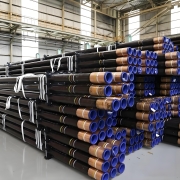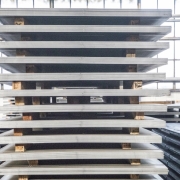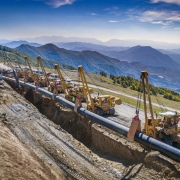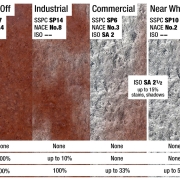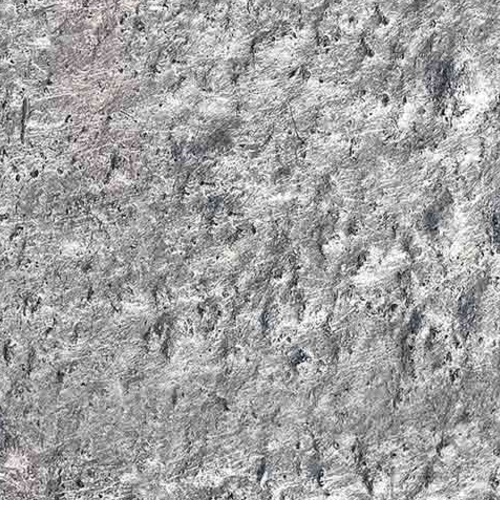9Cr, 13Cr, Super 13Cr, 22Cr y 25Cr en tuberías de revestimiento y de producción
Introducción
En la industria del petróleo y el gas, la selección de materiales para tuberías y entubados es crucial para garantizar la integridad, la seguridad y la eficiencia de las operaciones. La elección del material es fundamental en entornos donde la corrosión representa una amenaza importante. En este blog, analizaremos en profundidad las características específicas de varias aleaciones resistentes a la corrosión (CRA) que se utilizan habitualmente en tuberías y entubados de petróleo: API 5CT L80-9Cr, API 5CT L80-9Cr, 13Cr, Super 13Cr, 22Cr y 25CrExploraremos sus propiedades, aplicaciones y factores a la hora de seleccionar el material adecuado para su pozo.
Entendiendo el desafío: la corrosión en pozos de petróleo y gas
La corrosión es un problema generalizado en la industria del petróleo y el gas, especialmente en pozos con gases corrosivos como el CO₂ y el H₂S. Estos gases, a menudo combinados con altos niveles de cloruros, pueden provocar diversas formas de corrosión, entre ellas:
Corrosión uniforme:Una pérdida general del espesor del metal.
Corrosión por picaduras y grietas:Formas localizadas de corrosión que crean picaduras o grietas profundas, lo que puede provocar una falla rápida.
Agrietamiento por tensión de sulfuro (SSC) y agrietamiento inducido por hidrógeno (HIC)Causadas por H₂S, son formas críticas de corrosión que pueden provocar fallas catastróficas si no se gestionan adecuadamente.
Para combatir estos desafíos, la industria ha desarrollado una gama de CRA, cada uno con propiedades específicas adaptadas a diferentes entornos. A continuación, examinaremos algunos de los CRA más utilizados.
API 5CT L80-9Cr: La solución rentable para entornos con niveles moderados de CO₂
API 5CT L80-9Cr Es una aleación de acero inoxidable martensítico con contenido de cromo 9%. Se utiliza principalmente en pozos donde la corrosión por CO₂ es un problema, pero los niveles de H₂S son bajos a moderados.
Propiedades clave:
Resistencia a la corrosión:Proporciona buena resistencia a la corrosión por CO₂ pero es menos eficaz en entornos con alto contenido de H₂S.
Fuerza mecánica:Ofrece un buen equilibrio entre resistencia a la corrosión y resistencia mecánica, lo que lo hace adecuado para profundidades y presiones moderadas.
Económico:Una opción más económica que las aleaciones de mayor calidad, lo que la convierte en una opción popular para pozos donde las condiciones de corrosión no son demasiado severas.
Aplicaciones:
Pozos con niveles moderados de CO₂.
Entornos donde el contenido de H₂S es bajo o el SSC no es una preocupación principal.
API 5CT L80-13Cr: el estándar de la industria para pozos dulces
API 5CT L80-13Cr Se utiliza ampliamente en la industria del petróleo y el gas, en particular para pozos “dulces” con alto contenido de CO₂ pero bajo contenido de H₂S. Con cromo 13%, esta aleación ofrece una resistencia a la corrosión mejorada en comparación con el 9Cr, lo que la hace adecuada para una gama más amplia de entornos.
Propiedades clave:
Resistencia a la corrosión: Excelente resistencia a la corrosión por CO₂ y moderada resistencia a los cloruros. Capacidad limitada para servicio en condiciones ácidas.
Soldabilidad:Requiere un control cuidadoso durante la soldadura para evitar la formación de fases frágiles.
Propiedades mecánicas:Similar al 9Cr pero con resistencia a la corrosión mejorada, lo que permite su uso en entornos más agresivos.
Aplicaciones:
Pozos dulces con alto contenido de CO₂ y bajo contenido de H₂S.
En entornos con niveles moderados de cloruro, la corrosión por picaduras y grietas puede ser un problema.
Super 13Cr: resistencia mejorada para condiciones más agresivas
Súper 13Cr Es una versión avanzada del acero inoxidable 13Cr diseñada para ofrecer una resistencia superior a la corrosión en entornos más desafiantes. Con una resistencia mejorada a los cloruros y al H₂S, es adecuada para pozos que presentan un perfil de corrosión más agresivo.
Propiedades clave:
Resistencia a la corrosión mejorada:Mejor rendimiento en entornos con niveles más altos de cloruro y H₂S moderado.
Tenacidad:Tenacidad mejorada respecto al 13Cr estándar, lo que lo hace adecuado para condiciones más extremas.
Versatilidad:Se puede utilizar en entornos dulces y ligeramente ácidos, lo que ofrece flexibilidad en la selección del material.
Aplicaciones:
Pozos con niveles moderados a altos de CO₂ y H₂S.
Entornos donde el riesgo de corrosión por picaduras y grietas es elevado.
22Cr: La solución dúplex para entornos ácidos y ricos en cloruro
22Cr Es un acero inoxidable dúplex que contiene cromo 22%, lo que ofrece una combinación equilibrada de resistencia a la corrosión y resistencia a la corrosión. Su microestructura dúplex (una mezcla de fases austeníticas y ferríticas) le otorga una resistencia superior a la corrosión por picaduras, la corrosión por grietas y la corrosión por ...
Propiedades clave:
Alta resistencia:La estructura dúplex proporciona una mayor resistencia mecánica, lo que permite paredes más delgadas y componentes más ligeros.
Excelente resistencia a la corrosión: Adecuado para entornos con alto contenido de cloruro y servicio moderadamente ácido (H₂S).
Económico:Si bien es más caro que el 13Cr, el 22Cr ofrece un buen equilibrio entre rendimiento y costo, lo que lo convierte en una opción popular para muchas aplicaciones en alta mar y en aguas profundas.
Aplicaciones:
Pozos agrios con alto contenido de cloruro.
Pozos offshore y en aguas profundas donde la resistencia mecánica y la resistencia a la corrosión son críticas.
25Cr: El acero inoxidable súper dúplex para las aplicaciones más exigentes
25Cr, un acero inoxidable súper dúplex con cromo 25%, es el material ideal para los entornos de petróleo y gas más exigentes. Ofrece una resistencia a la corrosión incomparable, en particular en condiciones de servicio con alto contenido de cloruro y agrio, lo que lo hace ideal para pozos de aguas profundas y de alta presión y alta temperatura (HPHT).
Propiedades clave:
Resistencia superior a la corrosión:Excelente resistencia a picaduras, corrosión por grietas y corrosión bajo tensión en entornos agresivos.
Alta resistencia mecánica:La estructura súper dúplex permite utilizar componentes más delgados y livianos sin sacrificar la resistencia.
Fiabilidad:Proporciona un alto nivel de confiabilidad en entornos extremos, reduciendo el riesgo de fallas y el tiempo de inactividad asociado.
Aplicaciones:
Pozos de aguas ultraprofundas con altos niveles de CO₂, H₂S y cloruro.
Pozos HPHT donde tanto la resistencia a la corrosión como la resistencia mecánica son críticas.
Cómo elegir la aleación adecuada: guía práctica
La elección de la aleación adecuada para tuberías de revestimiento y de producción depende de un conocimiento profundo del entorno saludable y de las condiciones de funcionamiento. A continuación, se incluye una guía práctica que le ayudará a tomar una decisión informada:
Evaluar el entorno corrosivo: Evalúe los niveles de CO₂, H₂S y cloruro. Esto ayudará a determinar la resistencia a la corrosión necesaria.
Considere los requisitos mecánicos:Determinar la profundidad, la presión y la temperatura del pozo para comprender las demandas mecánicas del material.
Equilibrar costo y rendimiento:Las aleaciones de mayor calidad ofrecen un mejor rendimiento, pero también tienen un costo más alto. Equilibre el rendimiento del material con el presupuesto del proyecto.
Confiabilidad a largo plazo:Tenga en cuenta la confiabilidad a largo plazo y los costos de mantenimiento de cada material. Los costos iniciales más altos pueden justificarse por un mantenimiento reducido y una vida útil más prolongada.
Consultar normas y directrices:Cumplir con los estándares de la industria como NACE MR0175/ISO 15156 para servicio agrio para garantizar el cumplimiento y la seguridad.
Conclusión
En la industria del petróleo y el gas, la selección de materiales para tuberías y revestimientos es una decisión crítica que afecta la seguridad, la eficiencia y la rentabilidad de las operaciones petroleras. API 5CT L80-9Cr, API 5CT L80-13Cr, Super 13Cr, 22Cr y 25Cr ofrecen propiedades únicas adaptadas a diferentes entornos corrosivos y condiciones operativas. Al evaluar cuidadosamente las necesidades de su pozo y seguir las pautas descritas anteriormente, puede elegir la aleación que proporcione el mejor equilibrio entre resistencia a la corrosión, resistencia mecánica y rentabilidad.
Garantizar la selección correcta del material mejora la seguridad y confiabilidad de sus operaciones y contribuye al éxito general y la longevidad de sus pozos.

